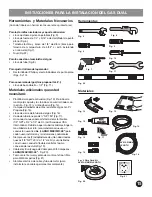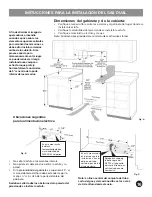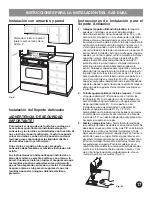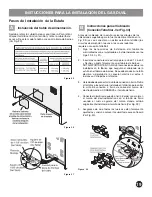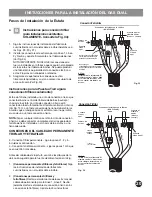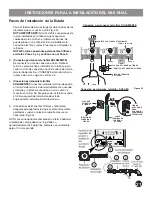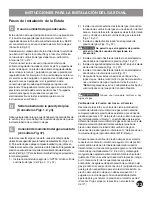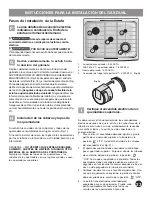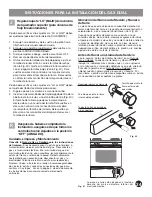
Range installation instructions
INSTALLATION INSTRUCTIONS FOR FREESTANDING DUAL FUEL
A
B
Seal the wall and floor openings
(Refer to Figs. 1, 2 & 3).
Seal any openings in the wall behind the range and in the floor
under the range after gas supply line is installed.
D
Provide an adequate gas supply.
This range is pre-set to operate on 4" natural gas manifold
pressure.
The Pressure R
egulator is connected to the
manifold and MUST be connected in series with the gas
supply line
(Refer to Fig. 37).
Care must be taken during installation of range not to
obstruct the flow of combustion and ventilation air. The
gas supply line should be 1/2" or 3/4" I.D.
For proper operation
, the maximum inlet pressure to the
regulator should be no more than 14 inches of water
column pressure. The inlet pressure to the regulator must
be at least 1 inch greater than regulator manifold pressure.
Examples: If regulator is set for natural gas 4 inch manifold
pressure, inlet pressure must be at least 5 inches; if
regulator has been converted for LP/Propane gas 10 inch
manifold pressure, inlet pressure must be at least 11
inches. Leak testing of the appliance shall be conducted
according to the instructions in Step E.
C
Connect the range to the gas supply
(refer to Fig. 37).
Before connecting gas supply to range,
review the
suggested power source location drawings
(Figs. 1, 3 &
4). To prevent leaks apply pipe joint sealant on all male
(outside) pipe threading. The Pressure Regulator can be
found mounted to the lower left rear of range (See Fig 37).
To install the gas supply:
E
1.) Install 1/2” NPT 90° Black Pipe Elbow to the gas supply
pipe stub (See Figs. 3, 17 & 37)
2.) Install an external gas Shut-Off Valve (manual) to gas
supply line in an easily-accessible location outside of the
range. Be sure you know how and where to shut-off the
gas supply to the range (Figs. 16 & 37).
3.) Install Flare Adapter* to gas Pressure Regulator (Figs. 19
& 37).
Do not allow the Pressure Regulator to turn
on pipe when tightening fittings.
4.) Attach flexible Appliance Conduit to Flare Adapter on
Pressure Regulator (Figs. 18 & 37).
5.) Install 2nd Flare Adapter* to external manual Shut-Off
Valve (Figs. 19 & 37).
6.) Attach flexible Appliance Conduit to Flare Adapter on
Shut-Off Valve (Fig. 37).
7.) After making these connections, check for gas leaks.
Turn the gas supply on to the range and use a liquid leak
detector at all joints and conduits to check for leaks in the
system.
*Note:
Be sure to use the 2 Flare Adapters
supplied with the Flexible Conduit Kit.
Do not use a flame to check for gas leaks.
Checking Manifold Gas Pressure:
Disconnect the range and its individual shut-off valve from
the gas supply piping system during any pressure testing
of that system at test pressures greater than 14" of water
column pressure (approximately 1/2" psig). The appliance
must be isolated from the gas supply piping system by
closing its individual manual shut-off valve during any
pressure testing of the gas supply piping system at test
pressures equal to or less than 14" of water column
pressure (approximately 1/2" psig).
If it should be necessary to check the manifold gas
pressure, connect manometer (water gauge) or other
pressure device to the top burner right rear orifice. Using
a rubber hose with inside diameter of approximately 1/4,"
hold tubing down tight over orifice. Turn burner valve on.
For an accurate pressure check have at least two (2) other
top burners burning. Be sure the gas supply (inlet)
pressure is at least one inch above specified range
manifold pressure. The gas supply pressure should never
be over 14" water column. When properly adjusted for
Natural Gas the manifold pressure is 4" (For LP/Propane
Gas the manifold pressure is 10").
Before servicing, disconnect electrical
supply at circuit breaker, fuse or Power Cord.
PLEASE READ CAREFULLY!
For
personal safety, this product must be properly grounded.
F
Read the electrical connection details
below. Plug the range into the wall
receptacle.
10

















